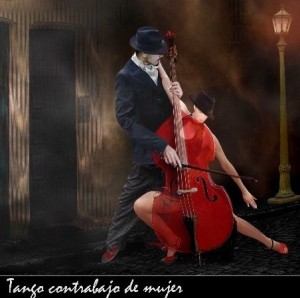Please read related post for tango leaders who want to soar.
 Since writing the post for leaders about “airborne tango” (not an infectious disease, maybe an infectious “at-ease”), I’ve thought about this state of weightlessness while dancing with various partners, how I soar when the points of contact, even with negative space, feel equally weight-bearing. Obviously this state is dynamic. You don’t affix yourself to your partner (kind of as they do in ballroom tango) and then stay there. You must be completely and perpetually aware, ever shifting, ever present, to find the balance. Like skiing, skateboarding.
Since writing the post for leaders about “airborne tango” (not an infectious disease, maybe an infectious “at-ease”), I’ve thought about this state of weightlessness while dancing with various partners, how I soar when the points of contact, even with negative space, feel equally weight-bearing. Obviously this state is dynamic. You don’t affix yourself to your partner (kind of as they do in ballroom tango) and then stay there. You must be completely and perpetually aware, ever shifting, ever present, to find the balance. Like skiing, skateboarding.
And, yet, not think too much about it.
There is a qualitative touching, nothing quantifiable about it, in this contact sport we call tango. It’s one of the many things that make tango experiential.
In this dynamic connection, followers, you have the lead. This may be the key to why experienced dancers feel there is no leader or follower, just a dance. The skillful leader doesn’t bumble into the dance partnership, grabbing you, deciding where and how to hold you. It’s a constant mutual decision. He or she waits and listens for subtle messages from you and your embrace, your posture, your distance or proximity to him/her, the way you place your head, the way your palms meet his/hers. The way you breathe.
A good leader recently described to me how all throughout a tanda, he didn’t know what to do about the woman’s head pressing so hard into him. It was distracting and there was no escaping it. I wondered how aware she was—it could have been a passive aggressive behavior and she might not even have been aware of it. It might have been that she was so accustomed to a skewed type of communication. But maybe it was something else more innocent. I have had the similar problem with men pressing my head so hard, I couldn’t relax into the flow of the dance, which in all other aspects might have been golden.
The awareness required for this smooth, pressure-free, equal-distribution connection is as easy as it is tricky. It requires not getting too hyper aware—not seeing the trees, not seeing the forest. A certain concentration is required and then paradoxically, you must also “de-concentrate” yourself—spread yourself and awareness around equally. Low-grade animal instinct? Maybe. I wouldn’t get too scientific about it. Already I’ve said way too much.
Years ago, a good dancer, a leader, told me how he didn’t like dancing with women who had just come from a certain teacher’s “women’s technique” class. I was not surprised. No doubt, the women were bringing the “fixed teaching” that they had just internalized by rote. But they failed to recognize that the class exercises are not the dance. The dance is born anew each time you step into the dance circle. It’s not memorized and had forever. It is like everyday life, a dance of constant instantaneous improvisation, constant reassessing where we’re at. You must meet your partner where you find him/her, not where the technique teacher told you he/she should be.
Consequently, adornos, the little extra decorations we do on our own are best when they happen without too much thought. You can watch dancers and tell whose adornos are naturally occurring and whose are premeditated. There is a disconnect in the picture of the latter. The partner feels it. The Princess and her pea has nothing on us tangueros with our acutely tuned senses.
How unveiled we are to each other in this dance! It’s only frightening if you’re afraid of your Self. No need to be. I’m awed by this seeming contradiction of how tango attracts macho men who must at the same time develop this deep full-body sensitivity. Something to ponder.
The most startling thing to read in my partner is fear. I’m never sure where his fear comes from—only he knows—but it affects the body almost identically to the way cold does. When threatened with hypothermia the body’s blood rushes to your core trying to offset the lowering temperature and preserve organs, so hands get stiff and claw-like, extremities clam up. You feel lightheaded because even the brain is getting deprived of nourishment. Fear seems to shape the body similarly so it’s hard to dance with a man experiencing this. I try to send messages of warmth, solace, and comfort, fun. Sometimes it works and when it does, it’s a gift to both of us.
Occasionally in older men (and women, I’m sure, too) fear has been such a constant companion that the body is so at home with clamming up, it has hardened with a hard shell of armor, curved posture. What a challenge to connect weightlessly with this person. But it can be an exercise in sharpening your own sensitivity and ability to meet the moment(um), meet the person. Like that old Shaker song, lyrics by Elder Joseph, which I bet you could tango to:
Tis the gift to be simple, ’tis the gift to be free,
‘Tis the gift to come down where we ought to be,
And when we find ourselves in the place just right,
‘Twill be in the valley of love and delight.
When true simplicity is gain’d,
To bow and to bend we shan’t be asham’d,
To turn, turn will be our delight,
Till by turning, turning we come out right.
Surely this man experienced tango. . .